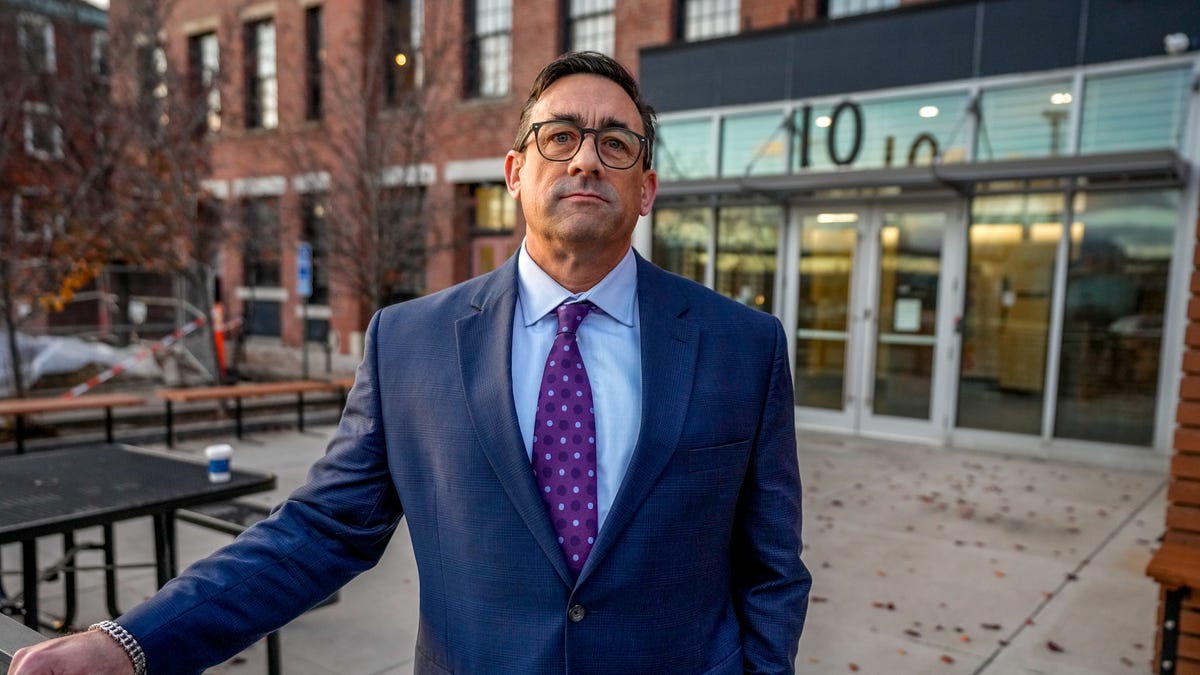Rhode Island
Primary care shortage; exodus at AG’s office; Airport Connector: Top stories this week

At Sweenor’s Chocolates, Candy Cane Making is a Family Business
Fourth generation candy makers, Sweenor’s Chocolates, make 2,400 candy canes in two days.
Here are some of The Providence Journal’s most-read stories for the week of Dec 3, supported by your subscriptions.
Here are the week’s top reads on providencejournal.com:
Long waits, frustrated patients and overworked health care staff are symptoms of a doctor shortage that has pushed providers to the brink of burnout. The crisis has been building nationally for years, causing the head of the American Medical Association to raise alarms over doctors saddled with college debt and stretched to exhaustion.
Rhode Island is no exception, particularly when it comes to primary care. The people tasked with monitoring your health to prevent disease and treat illnesses are leaving their jobs. Blame workplace pressures, low Medicare reimbursement rates, administrative hassles and retirement.
A new study says Rhode Island will need nearly 100 more primary care physicians in the next six years to keep up with demand.
Health care: ‘How did this happen?’ Primary care shortage keeps hitting RI hard
The Rhode Island attorney general’s office has seen high turnover over the last three years, particularly among some of its most seasoned lawyers, records requests and analysis by The Providence Journal shows.
More than 150 employees have left since 2019, with some taking significant pay cuts to do so. The high turnover – which has seen almost the entire Civil Division depart – is affecting how cases are proceeding in federal court, causing discovery delays and resulting in lawyers being assigned to complex cases on short notice and scrambling to get up to speed.
While experts say the legal system – like many professions – is experiencing high turnover nationwide, particularly since the COVID pandemic, the exact cause of the lawyer exodus remains murky.
The AG’s office said such movement is normal, and the department is steadily hiring to fill vacancies. But several departed lawyers described a culture of mismanagement, strict top-down leadership by Attorney General Peter Neronha and his administrative team, and an environment in which their experience wasn’t valued and questions weren’t tolerated. They reported feeling sidelined and mistreated.
Courts: More than 150 employees have left the AG’s office since 2019. What that means for RI.
Road construction projects are happening all around the state all the time. There’s the new Interstate 95 North project, the tireless work on the Pell Bridge, and the new roundabout at the Henderson Bridge.
This week, What and Why RI looks into a smaller Rhode Island Department of Transportation project under construction in the grassy area next to I-95.
“What is being built in the intersection of I-95 and the Airport Connector in Warwick?” a reader wrote in to ask, referring specifically to the wall-metal frame that recently went up.
Here’s what we found out.
What and Why RI: What are they building by the Airport Connector and I-95 intersection? We found out.
Retired Providence Municipal Court judge and former “Caught in Providence” star Frank Caprio is suffering from pancreatic cancer, he announced on social media.
“I would ask each of you in your own way to please pray for me,” Caprio said in a video posted to Facebook.
Caprio said he is being treated by “a wonderful team of doctors” in Rhode Island and at Boston’s Dana Farber Cancer Institute.
“I pray that God guides their thoughts and their hands in their treatment of me,” Caprio said.
Local news: Judge Frank Caprio announces pancreatic cancer diagnosis
As home to one of the five best Little Italys in America, Rhode Island has one of the finest Italian food scenes you’ll find outside of Italy.
With so many options, the hardest part is deciding which restaurant to visit.
The Providence Journal asked readers to nominate places to include in the poll on our Instagram page @ProJoEats, which we then compiled into a true poll asking people to vote for their favorite. Here are the top seven reader picks.
Dining: Rhode Island’s best Italian restaurant? Here are 7 reader picks
To read the full stories, go to providencejournal.com. Find out how to subscribe here.

Rhode Island
5 places to go ice skating in Rhode Island this winter
Watch as families try to skate on the ice rink in Yoctangee Park
The ice rink is open on weekends this month in the park thanks to the Mighty Children’s Museum.
With the excitement of the holiday season over, it may seem like the best way to wait out the cold New England winter is staying indoors.
However, if you can work up the courage to face the cold, Rhode Island has plenty of attractions that can brighten up the gloomiest winter day, including ice skating. Whether indoor or outdoor, plenty of ice rinks can be found throughout the state, many of which offer more than ice skating.
Here are five rinks in Rhode Island to skate at this winter.
Providence Rink
Located in the heart of downtown Providence is BankNewport City Center’s Providence Rink, an outdoor winter sports venue that offers both ice skating and ice bumper cars against a backdrop of the city skyline. The rink was recently renovated.
Tickets cost $13 for shared bumper cars, $16 for full bumper cars, $9 for adult skating and $6 for child skating. Skate rentals and season passes are also available.
When: Ice skating is open daily from 10 a.m.-10 p.m. through early March.
Where: 2 Kennedy Plaza, Providence
Thayer/Warburton Arena
Warwick’s Thayer and Warburton ice arenas offer year-round indoor ice skating for competitive, recreational, resident and non-resident skaters. Along with public skating hours, this venue offers adult-only skate time, private group rentals and skating lessons.
Skating costs $5 per person, and skates can be rented from the Sandy Lane Sports store across the street.
When: From January through March, public skate hours are 3:15-5:15 p.m. on Fridays and 12:50-2:30 p.m. on Sundays, and adult skate hours are 8-11:30 a.m. on Mondays, Wednesdays and Fridays.
Where: 975 Sandy Ln., Warwick
Washington Trust Community Skating Center
This outdoor rink offers 12,000 sq. ft. of real ice to skate on, with options including free skate, skating lessons, hockey and Rock N Skate, a fun-filled event with skating and music, every Saturday night. Food concessions are also available outside the rink.
The price to skate at the Washington Trust Community Skating Center is $10 for adults or $7 for both children 13 or under and seniors 60 or over. Guests can rent skates for $7 and get the blades sharpened for $5.
When: Westerly’s community ice rink is open for public skating from 3-4:50 p.m. on Tuesdays and Thursdays, 10-11:50 a.m. and 3-6:50 p.m. on Fridays, 10 a.m.-5:50 p.m. on Saturdays and 1-4:50 p.m. on Sundays. A full schedule of all events can be found on the town of Westerly’s website.
Where: 61 Main St., Westerly
Cranston Veterans Memorial Ice Rink
The Cranston Veterans Memorial Ice Rink has not one, but two NHL regulation size rinks, where skaters can enjoy public skating, public hockey, skating with stick and puck or skating lessons.
Outside the rink, this venue has a Pro Shop, arcade games and a concession stand, stocked with snacks like pizza, popcorn and slushies.
Skating costs $10 for adults or $5 for children and senior citizens, and skate rentals are available for $10. The Cranston rink only accepts cash.
When: Public skating is open daily from 12:10-2 p.m.
Where: 900 Phenix Ave., Cranston
Smithfield Municipal Ice Rink
Along with hosting various sports groups and teams, Smithfield’s indoor ice rink offers both public skating and public hockey.
Tickets to skate, which can only be bought in person with cash, cost $5 per person, and skate rentals cost an additional $5.
When: Smithfield’s public skating hours are 12-1:30 p.m. on Tuesday, Friday and Sunday.
Where: 109 Pleasant View Ave., Greenville
Rhode Island
RI Lieutenant Governor Sabina Matos meets in Israel to 'strengthen relations' | ABC6

PROVIDENCE, R.I. (WLNE) — The Office of Rhode Island Lieutenant Governor Sabina Matos announced she traveled to Israel on Monday to meet with the Consulate General of Israel to New England.
The meeting was planned as part of a legislative delegation to strengthen the relationship between Rhode Island and Israel.
Lieutenant Governor Matos is set to return from Israel on Jan. 31.
Matos’ office said no taxpayer funds were used for the travel.
Rhode Island
Speaker Shekarchi met with influential people in R.I. politics while on a Florida vacation. Will he run for governor? – The Boston Globe

Sabitoni is the vice chair of the University of Rhode Island Board of Trustees.
Shekarchi downplayed the idea that the two were meeting about next year’s governor’s race, which the speaker and his $3.1 million (and growing) campaign account can’t seem to avoid being asked about despite his own denials that he is planning a run.
Shekarchi also said he met with lobbyist Lenny Lopes, who earns $5,000 a month to lobby for Meta (Facebook), while in Florida. As you might imagine, Meta opposes Governor Dan McKee’s budget proposal to impose a 10 percent tax on digital advertising.
The bigger picture: If you believe Rhode Island politics weren’t discussed when Shekarchi and Sabitoni met in Florida, I’ve got a bridge in East Providence to sell you.
Sabitoni is precisely the kind of person a Democratic candidate for governor would want in his or her corner, but there’s one hiccup at the moment: Sabitoni has been among McKee’s top supporters since he took office in 2021.
Shekarchi has maintained that he won’t run against McKee, but he hasn’t ruled out entering the race if McKee were to take a look at his middling approval ratings and take a pass on running for reelection next year. McKee has repeatedly said he does plan to run again.
Meanwhile, Democrat Helena Foulkes, who finished second against McKee in the 2022 Democratic primary, has all but formally declared that she is running again next year.
What’s next: All Rhode Island politicians have to report their campaign fund-raising totals on Friday night, and you can expect Shekarchi, McKee, and Foulkes to continue growing their sizable war chests.
In many ways, time is on Shekarchi’s side. While he doesn’t quite have the name recognition as McKee or the personal wealth of Foulkes, he has more power as the speaker than either of them. It has been notable that he has expressed more frustration with McKee’s Department of Housing in recent weeks.
I was up bright and early to discuss today’s edition of Rhode Map on “12 News This Morning.”
This story first appeared in Rhode Map, our free newsletter about Rhode Island that also contains information about local events, links to interesting stories, and more. If you’d like to receive it via email Monday through Friday, you can sign up here.
Dan McGowan can be reached at dan.mcgowan@globe.com. Follow him @danmcgowan.
-

 Culture1 week ago
Culture1 week agoBook Review: ‘Somewhere Toward Freedom,’ by Bennett Parten
-

 Business1 week ago
Business1 week agoOpinion: Biden delivered a new 'Roaring '20s.' Watch Trump try to take the credit.
-

 News1 week ago
News1 week agoJudges Begin Freeing Jan. 6 Defendants After Trump’s Clemency Order
-

 Business5 days ago
Business5 days agoInstagram and Facebook Blocked and Hid Abortion Pill Providers’ Posts
-

 News3 days ago
News3 days agoHamas releases four female Israeli soldiers as 200 Palestinians set free
-

 Politics4 days ago
Politics4 days agoOklahoma Sen Mullin confident Hegseth will be confirmed, predicts who Democrats will try to sink next
-

 World3 days ago
World3 days agoIsrael Frees 200 Palestinian Prisoners in Second Cease-Fire Exchange
-

 News1 week ago
News1 week agoA Heavy Favorite Emerges in the Race to Lead the Democratic Party


















